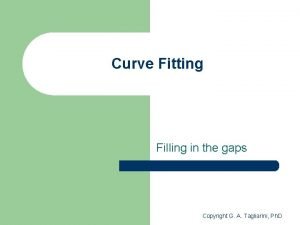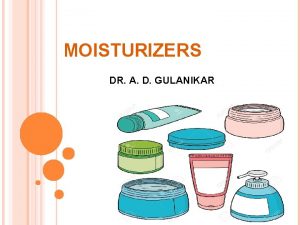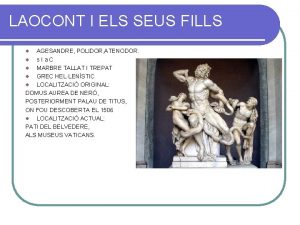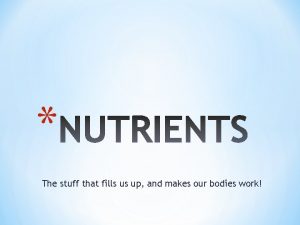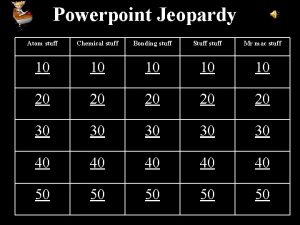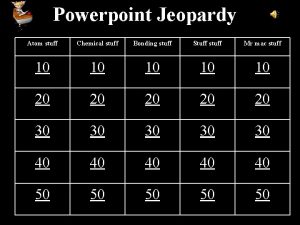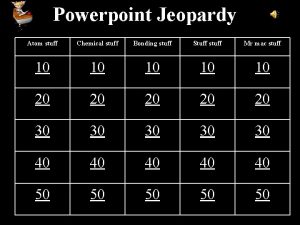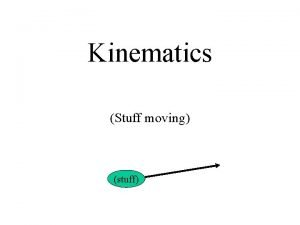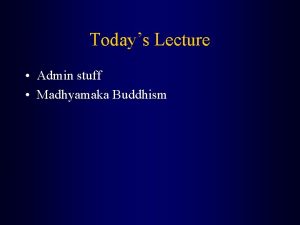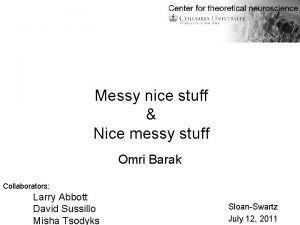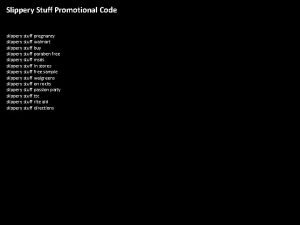The stuff that fills us up and makes














- Slides: 14

* The stuff that fills us up, and makes our bodies work!

*Definition *Bad nutrition *A condition that develops from over or under consumption of energy/nutrients *Examples: * Over-nutrition – obesity, type 2 diabetes, cardiovascular disease, cancers * Occurs when energy intake is more than energy output * Most common in North America * Typically due to high fat diet * Under-nutrition – kwashiorkor, goiter, xerophalmia * Malabsorption, diet lacking micronutrients, diet lacking macronutrients *

* *MACRONUTRIENTS *The main nutrients that the body needs in large portions *MICRONUTRIENTS *Nutrients that the body needs in lesser portions

*Carbohydrates (CHO) *(C)arbon; (H)ydrogen & (O)xygen *Photosynthesis of plants – therefore the SOURCE is grains and vegetable & fruit group of the food guide (also dairy) *Function – energy *Types – complex/polysaccharides (starches, glycogen, cellulose) and simple/mono/disaccharides(sugars) *Fibre – soluble and insoluble *


*Fats *Function * Energy, flavour, essential fatty acids * Dissolves and carries in the body vitamins A, D, E & K * Many more… insulation, protection, nerve transmission… *Sources * Meat, dairy, nuts and seeds, oils/margarines, lesser amounts in fruits and vegetables *

*Types *Generally are all (95%) triglycerides – made of a gycerol chain and 3 fatty acids * Saturated – animal sources – solid at room temperature * Unsaturated – plant sources – liquid at room temperature * Monounsaturated (MUFA) * Polyunsaturaed (PUFA) ESSENTIAL – body cant make it *The other 5% of fat is cholesterol (from egg yolks) *

*Protein *Built of AMINO ACIDS * There are lots of amino acids – only 9 are essential – meaning they are not produced in the body *Function * Build and repair body tissues * Enzymes, antibodies, metabolic, fluid balance, cell structure, hormones, transportation… *Types * Complete – contains the 9 essential amino acids, from animal sources * Incomplete – missing 2 or 3 essential amino acids, from plant sources *

*Vitamins *Function * Regulates body processes – each vitamin affects different systems/processes * Do NOT produce energy * Antioxidants, vision, mineral absorption, blood clotting, bone production *Types * Fat Soluble – A, D, E, & K * Water Soluble – B’s (thiamine, riboflavin, b 12, folic acid, niacin) & C *Sources * Many types of foods especially fruits * and vegetables * Food can also be enriched/supplemented/ fortified

*Minerals *Function * Regulate body processes such as healthy teeth, bones, fluid balance, muscle contractions, oxygen transport in blood, and nervous system function *Types * Major – calcium, phosphorus, sodium, chloride, potassium, magnesium – body needs more than 100 mg * Trace – iron, iodine, fluorine, zinc – body needs less than 100 mg *Sources * Enter food we eat from soil or foods can be enriched/supplemented *

*Water *Up to 70% of our body is water * Muscles – 75% water * Fat – 50% water * Bone – 50% water * Blood – 90% water *Need 8 glasses of fluids per day *If you are thirsty you are already dehydrated *

*Functions * Transports nutrients/waste in body * Lubricates joints * Regulates body temperature * Digestive, absorption, circulatory and excretory functions *Can only live approximately 2 days without any source of water, whereas you can live weeks or months without food *

* *What are the 2 groups of nutrients called? * Macronutrients * Micronutrients *What are the 3 macronutrients? * Carbohydrates * Fat * Protein *What are the 2 micronutrients? * Vitamins * Minerals *What is the MOST important nutrient? * WATER!

* * What was one of the functions of CHO? * What is one of the TRACE minerals? * What are the FAT soluble vitamins? * How do you get all essential amino acids? * How can you tell the difference between saturated and unsaturated fat? * What is malnutrition? * WHAT OTHER FUN FACTS DID YOU LEARN ABOUT NUTRIENTS? ! =)
 Ngoại tâm thu thất chùm đôi
Ngoại tâm thu thất chùm đôi Block xoang nhĩ độ 2
Block xoang nhĩ độ 2 Thơ thất ngôn tứ tuyệt đường luật
Thơ thất ngôn tứ tuyệt đường luật Thơ thất ngôn tứ tuyệt đường luật
Thơ thất ngôn tứ tuyệt đường luật Walmart thất bại ở nhật
Walmart thất bại ở nhật Tìm độ lớn thật của tam giác abc
Tìm độ lớn thật của tam giác abc Hãy nói thật ít để làm được nhiều
Hãy nói thật ít để làm được nhiều Tôn thất thuyết là ai
Tôn thất thuyết là ai Gây tê cơ vuông thắt lưng
Gây tê cơ vuông thắt lưng Sau thất bại ở hồ điển triệt
Sau thất bại ở hồ điển triệt Fills in gaps in data and fit data into curves
Fills in gaps in data and fit data into curves And then my heart with pleasure fills figure of speech
And then my heart with pleasure fills figure of speech Type of emollient
Type of emollient Laocoont i els seus fills
Laocoont i els seus fills Laocont
Laocont










